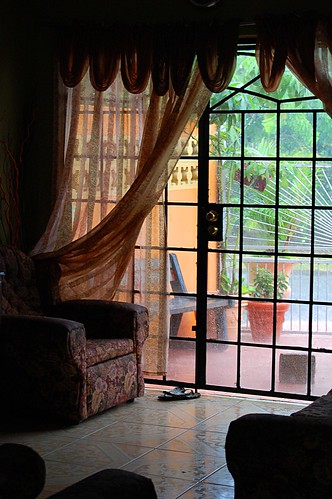
This was a very modern adaptation of bungalow styled homes.
From the beginning I acknowledged that I had a fascination with pre-independence homes. My motivation to take pictures of these houses stemmed from the ongoing controversy concerning conservation. If I were not introduced to the topic at all during my stay in Trinidad, surely I would have taken a few tourist pictures of the homes for my private collection. However, I was informed about the lack of awareness governing the importance of these homes and I deemed it necessary to save some that are on the verge of extinction. Why? Something pulled me in that direction. The houses are beautiful on the surface yet it has so much relevance within the context of Trinidadian history.
In a previous blog, the Phenomenology of Space, I expressed how discouraged I was with the fact that I felt nothing when interacting with various spaces. At the time we were walking in Newtown, but I also felt the same apathy towards older houses in other parts of POS. That was alarming to me because I thought I should feel something, anything, when interacting with the spaces I eagerly expressed interest in before. Now I realize that the nothing I felt was in fact something. Something is pulling me towards these homes, but I cannot articulate what that something might be. I thought that my interest did not go beyond the aesthetics of the house and I watch in amazement every time I pass the magnificent seven, but I had to wait until I photographed a modern house to recognize my appreciation.

Taking pictures in the Trincity house was difficult because of inefficient light. The dark/light contrast is not intention in this picture as it was in the Gingerbread series.
As I stood outside of the first house in Trincity I found myself looking for things to take pictures of and it was that moment when I realized how my interaction with the older houses are in fact more than nothing. Typically when I photograph pre-independence homes I would point and shoot. Just like that. Everything was intriguing and beautiful; the shapes were extraordinary and the shadows were somehow different from the image it originated from. On the other hand, the bungalow in Trincity did not have the same effect. Instead I had to create reasons explaining why I was taking the picture. For example, the tiled walkway wasn’t interesting to me but I reasoned that since old houses were also tiled it was significant to compare the two, so I took a picture. I was not interacting with the house on the same level as the old ones and worse yet was when I took pictures of the interior.
Taking shots of the interior was extremely difficult because the lighting was terrible. When I photographed another version of the Gingerbread house I did not depend on artificial light. Breeze and light passed through the house freely and it was more than enough to take pictures while keeping my body at a comfortable temperature. The Trincity house was dark and even though the homeowners explained that they knocked down walls to open up the space, it was too difficult to capture images (unless I had a tripod). Interacting with the spaces in Trincity proved that the structure of a house crucially influences the way people feel and maneuver within the space.
After I left the gingerbread house I felt as though I wasn’t finished, like I still needed to take more pictures. Of what? I have no idea, because the house was small and I don’t think I missed too many architectural details. If I went back I would be capturing the same type of images, but after photographing the bungalows in Trincity I felt quite opposite. Once I stopped taking pictures, that was it, I did not want or feel the urge to take more. The houses in Trincity were different from the pre-independence houses I encountered throughout Trinidad. I am always amazed to see wooden structures surrounded by concrete houses in areas like Tunapuna and Arima. It just reminds me that at one point all of the houses looked like gingerbread houses with detailed fretwork and front porches. Interestingly enough, I think it is easier to find a deteriorating house than to find an untouched bungalow. It was common to find renovated bungalows in Trincity but people are less likely to renovate colonial houses. Perhaps that can attributed to the fact that it’s easier to maintain a bungalow since concrete does not deteriorate as fast as wood.
The materials used nowadays are not very conducive to the environment; however, lamenting on the past does not really change anything. Yes, the older homes are beautiful photographic specimans, but people are not intersted in functional beauty they are more intersted in dysfuncctional progression. Simplicity and comfort comes with a price.
0 comments:
Post a Comment